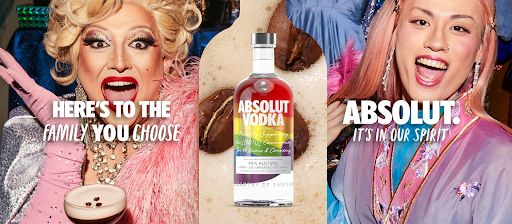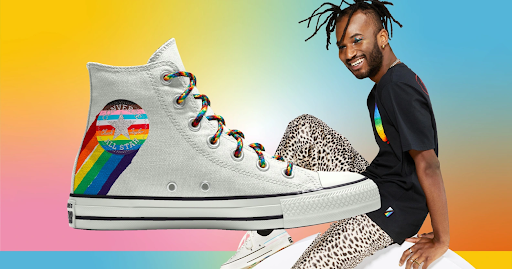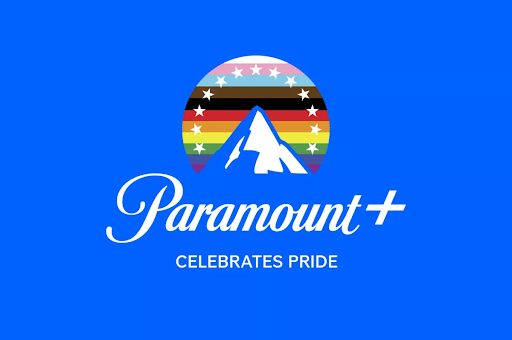
Pride logo design Image by absolut.com
Let’s discuss pride logo designs. As Pride month draws to a close, we’ve witnessed numerous brands embracing and expressing their support. Through the integration of Pride logos and branding into their strategies. Throughout this period, we’ve encountered a multitude of inspiring Pride branding initiatives, as well as some less impactful ones. To assist you in navigating this realm, we’ve prepared a comprehensive guide on creating and effectively incorporating a Pride logo. As well as integrating Pride branding seamlessly into your overall strategy.
Within this article, we will delve into the following topics
- The significance of pride logos in branding
- Evolution of pride logos in corporate branding
- The impact of pride logos on consumer perception
- Examples of successful pride logos
- Designing a pride logo for your company
- Incorporating pride logos into your brand identity
- Pride logo controversies and how to navigate them
- Conclusion: The future of pride logos in branding
The significance of pride logos in branding
In today’s diverse and inclusive world, it has become crucial for businesses to align their branding with the values and beliefs of their target audience. One way companies are doing this is through the use of pride logos. These logos, often featuring vibrant rainbows or other symbols associated with the LGBTQ+ community, are a powerful statement of support and inclusivity.
Pride logos are not just about showing solidarity with the LGBTQ+ community. Furthermore, they also represent a commitment to embracing diversity and fostering a culture of acceptance. By incorporating pride logos into their branding, companies are signaling to both employees and customers that they are a safe and inclusive space for everyone. Regardless of sexual orientation or gender identity. This not only helps attract and retain diverse talent but also cultivates a loyal customer base that values companies that stand up for social justice.
The use of pride logos in branding is particularly important during Pride Month. A time when the LGBTQ+ community celebrates its history, culture, and achievements. By prominently displaying pride logos during this month, companies show their support and solidarity. While also reaching out to LGBTQ+ consumers who actively seek out brands that align with their values. Pride logos not only serve as a visual representation of a company’s commitment to inclusivity but also act as a beacon for like-minded individuals. Creating a sense of community and belonging.
Evolution of pride logos in corporate branding
Over the years, the design and representation of pride logos in corporate branding have evolved significantly. In the past, companies may have simply added a rainbow flag to their existing logo during Pride Month. While this was a step in the right direction, it often felt like a token gesture rather than a genuine commitment to inclusivity.
Today, companies are taking a more thoughtful and intentional approach to pride logos. They are investing in designing unique and powerful logos that not only capture the spirit of Pride Month but also reflect their brand identity. These logos may incorporate elements such as rainbows, hearts, or other symbols associated with the LGBTQ+ community. However, they do so in a way that feels authentic and aligned with the company’s values.

Image by converse thepinknews.com
Many companies now collaborate with LGBTQ+ designers, organizations or individuals to create their pride branding or collections. Converse, the American shoe company, may have opted not to update its logo on social media. However, it wholeheartedly embraces Pride through an extensive lineup of custom sneakers. Each design showcases a distinctive rainbow Converse logo. Along with other vibrant rainbow elements, making a bold statement. In addition to their visually striking aesthetics, these Pride-themed sneakers exemplify Converse’s unwavering support for the LGBTQIA+ community. Mainly by collaborating with various community partners. Providing grants and harnessing the passion of its diverse and inclusive team.
These efforts not only ensure that the logos and branding are culturally sensitive. But also provides opportunities for LGBTQ+ artists to showcase their talent and be recognized for their contributions. The evolution of pride logos in corporate branding reflects a growing understanding of the importance of authentic representation. Adding to the need to go beyond surface-level gestures of support.
The impact of pride logos on consumer perception
The use of pride logos in branding has a profound impact on consumer perception. When consumers see a company proudly displaying a pride logo, it sends a powerful message that the company values diversity and inclusivity. This, in turn, fosters trust and loyalty among consumers. Especially those who identify as LGBTQ+ or are strong allies of the community.
Understanding the synergies between branding and the human brain enables you to effectively communicate your brand’s values. Including its commitment to inclusivity and diversity, to your consumers.
Research has shown that consumers are more likely to support brands that are actively engaged in social issues and demonstrate a commitment to equality. By incorporating pride logos into their branding, companies are not only attracting a diverse customer base but also creating a sense of authenticity and credibility. Consumers can see that the company’s support for the LGBTQ+ community goes beyond mere words and is backed by tangible actions.
Furthermore, pride logos can act as a catalyst for conversations and awareness. When consumers see a pride logo, it prompts them to think about and discuss topics related to LGBTQ+ rights and equality. This increased visibility and dialogue help break down barriers. Furthermore to challenge stereotypes, and promote understanding. Pride logos have the power to spark meaningful conversations that contribute to a more inclusive society.
Examples of successful pride logos
Several companies have successfully integrated pride logos into their branding. Setting an example for others to follow. One notable example is the Paramount+ logo which they have launched to celebrate pride month with their ‘mountain of pride’ collection.

The seamless transformation of the mountain into a vibrant canvas for the rainbow is captivating. Notably, the incorporation of the rainbow within the + sign adds an extra touch of brilliance (as showcased below). Paramount+ has exemplified its dedication to promoting visibility over financial gain this year by actively supporting Pride. With an extensive array of curated content, the streaming service highlights the remarkable talent and compelling stories of LGBTQIA+ individuals in film and TV.

Another example is Mercedes-Benz which proudly displays its Pride logo in various locations. Including on the Mercedes-AMG Petronas F1 Team cars for the upcoming three races. Beyond visual representation, Mercedes-Benz also supports InReach (formerly AsylumConnect), a tech nonprofit organization dedicated to connecting LGBTQ+ individuals with safe and verified resources. It is crucial to acknowledge and applaud brands that not only embrace symbolic gestures but also back them up with tangible actions. We hope to see more of such initiatives, and we appreciate the appealing designs as well.

These examples demonstrate that successful pride logos are those that authentically reflect a company’s values, resonate with their target audience, and go beyond surface-level gestures of support. Pride logos should be thoughtfully designed, culturally sensitive, and align with the overall brand identity.
Designing a pride logo for your company
If you are considering incorporating a pride logo into your company’s branding, it is essential to approach the design process with care and intention. Here are some steps to guide you:
- Understand your brand identity: Before designing a pride logo, it is crucial to have a deep understanding of your brand identity and values. Ask yourself how the pride logo will fit into your overall branding strategy and what message you want to convey.
- Research LGBTQ+ symbols and history: Familiarize yourself with the symbols and history of the LGBTQ+ community to ensure that your pride logo is culturally sensitive and respectful. Avoid appropriating symbols without understanding their significance.

Image by Copacino+Fujikado
- Collaborate with LGBTQ+ designers or organizations: Consider partnering with LGBTQ+ designers or organizations to create your pride logo. This collaboration not only ensures authenticity but also provides an opportunity to support and uplift LGBTQ+ talent.
- Test and gather feedback: Once you have a design concept, test it with a diverse group of stakeholders, including LGBTQ+ individuals. Gather feedback and make any necessary adjustments to ensure that your pride logo resonates with your target audience.
Remember, designing a pride logo is not just about following a trend or ticking a box. It is about making a genuine commitment to inclusivity and creating a visual representation of your company’s values.
Incorporating it all into your brand identity

Once you have a well-designed pride logo, it is essential to integrate it seamlessly into your brand identity. Here are some tips to help you do so:
Consistency is key: Ensure that your pride logo aligns with your existing branding elements, such as color palette (read more about the significance of colors in logo design
- and typography (more about the psychology of fonts here). This consistency helps create a cohesive visual identity.
- Use it across various touchpoints: Display your pride logo prominently on your website, social media profiles, packaging, and marketing materials. The more visible it is, the stronger the message of inclusivity.
- Educate your employees: Share the significance of your pride logo with your employees and encourage them to embrace it. This internal alignment helps create a culture of inclusivity within your organization.
Engage with the LGBTQ+ community: Go beyond just displaying a pride logo and actively engage with the LGBTQ+ community. Support LGBTQ+ events, sponsor organizations, and listen to the voices of the community.
By incorporating your pride logo into your brand identity, you are making a statement that goes beyond a one-time campaign or event. It becomes a part of who you are as a company and reinforces your commitment to inclusivity.
Pride logo controversies and how to navigate them
It is important to acknowledge that the use of pride logos can sometimes be controversial. Some individuals or groups may perceive it as a form of “rainbow capitalism” or accuse companies of exploiting the LGBTQ+ community for profit. To navigate these controversies, here are some strategies:
- Be transparent and authentic: Clearly communicate your company’s values and commitment to the LGBTQ+ community. Show that your pride logo is not just a marketing ploy but a genuine expression of support.
- Listen and learn: When faced with criticism or controversy, listen to the concerns raised by the LGBTQ+ community. Engage in open and respectful dialogue, learn from the feedback, and make any necessary changes to ensure your pride logo is aligned with the community’s needs.
- Collaborate with LGBTQ+ organizations: Partner with LGBTQ+ organizations or experts to ensure that your pride logo is culturally sensitive and respectful. Seek their guidance and input throughout the design and implementation process.
- Avoid tokenism: Avoid using your pride logo as a one-time gesture or a mere marketing tool. Instead, strive for meaningful and ongoing engagement with the LGBTQ+ community. Show that your commitment goes beyond Pride Month and is reflected in your actions throughout the year.
By approaching pride logos with sensitivity, authenticity, and a commitment to ongoing dialogue, companies can navigate controversies and ensure that their support for the LGBTQ+ community is genuine and impactful.
Conclusion: The future of pride logos in branding
Pride logos have come a long way in revolutionizing branding and fostering inclusivity. As society continues to progress towards greater acceptance and understanding, the importance of pride logos will only grow. In the future, we can expect to see even more innovative and authentic approaches to incorporating pride logos into branding strategies.
However, it is essential for companies to remember that pride logos are not just a trend or a marketing strategy; they represent a commitment to equality and social justice. By embracing pride logos and actively supporting the LGBTQ+ community, companies can create a lasting impact, foster loyalty among consumers, and contribute to a more inclusive society.
So, if you’re looking to craft a pride-focused branding strategy, look no further than THE LOGO COMPANY! Our team of talented designers have spent endless hours designing and crafting logos which capture the values of LGBTQ+ community for brands across many industries. We take a flexible and unique approach to branding, so you can trust us to deliver a logo that perfectly captures your brand’s values of pride. Get in touch with us now to get started.
